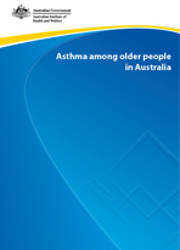Summary
Asthma in older Australians is distinct in many ways. The presence of comorbid conditions makes the management of asthma in older people more complex. The disease itself is also more persistent and severe than in the younger ages. Over 92% of the 402 asthma deaths in 2006 were among people aged 45 years and over, with many being associated with chronic obstructive pulmonary disease or bronchiectasis and acute respiratory infections.
This report highlights key national data relating to asthma in older Australians:
- There are two broad patterns of asthma prevalence over the life course. The older pattern begins around 45 years of age.
- Among older Australians, asthma is more prevalent among females (10.8%) than males (7.4%) but the gender difference lessens with age.
- There was little change in asthma prevalence in older Australians between 2001 and 2004–05.
- Asthma is considerably more prevalent among older Indigenous (19.4%) than non-Indigenous (9.1%) Australians of the same age (45 years and above), particularly among females (25.4% compared to 10.7% for non-Indigenous females).
- In 2004–05, the prevalence of asthma in older Australians was significantly higher for those living in the most disadvantaged localities, compared with the least disadvantaged localities.
- The number of asthma deaths was unexpectedly high in 2006 and 2007, considering the declining trend of the previous years. These relatively high death rates particularly affected the 70+ years age group. No single cause for this increase can be identified and data for further years are required before it can be ascertained if the increase in deaths has been sustained.
- The rate at which asthma is managed in primary care declined between 1998–99 and 2007–08.
- The asthma hospital separation rate in older Australians declined between 1999–00 and 2006–07 by around 40% and the average length of stay also fell.
- Acute respiratory infection in asthma sufferers appeared to increase between 1998 and 2006. This occurred despite relatively stable infection rates in the general population.



